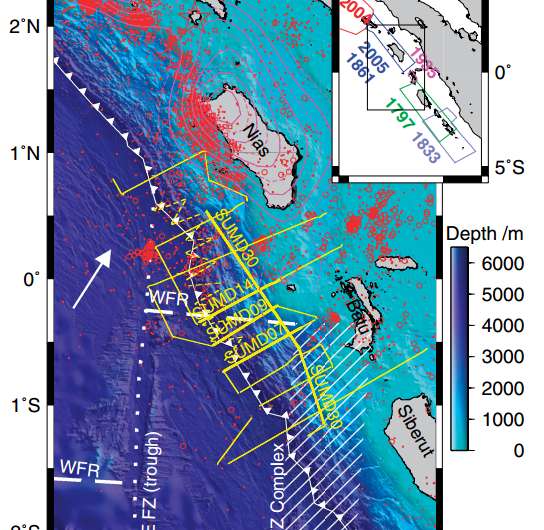Mapping downgoing plate topography—the 2005 Sumatra earthquake

New geophysical data show that fault slip during the March 2005 magnitude 8.7 (Mw) earthquake off the west coast of northern Sumatra, Indonesia (also referred to as the Simeulue-Nias earthquake), was stopped by the topography on the downgoing plate.
Earthquakes in subduction zones, where one tectonic plate is forced beneath another, usually break only a part of the plate boundary fault. The pieces that break independently are known as segments. Topography on the top of the downgoing plate has often been suggested a cause of this segmentation, but there are few examples where this topography is as well-known as well as the details of earthquake rupture.
Data collected over the subduction zone offshore of Sumatra, Indonesia, has enabled the top of the downgoing plate to be mapped across a long-lived segment boundary at one end of the rupture zone. Seismic reflection data, similar to that used to find oil reserves, gives a detailed image of the shape of the downgoing plate. A 3-km high on the top of the plate over a 15-km by 30-km region matches where the 2005 earthquake rupture stopped. The topographic high appears to strengthen the plate boundary, and only very large earthquakes would break through this barrier.
This survey by Timothy Henstock and colleagues spans a complex segment boundary zone between the southern termination of the Mw 8.7 earthquake and the northern termination of a major 1797 earthquake that was partly filled by a Mw 7.7 event in 1935. They have identified an isolated 3 km basement high at the northern edge of this zone, close to the 2005 slip termination. They note that the high probably originated at the Wharton fossil ridge, and is almost aseismic in both local and global data sets, suggesting that while the region around it may be weakened by fracturing and fluids, the basement high locally strengthens the plate boundary, stopping rupture propagation.
More information: Timothy J. Henstock et al. Downgoing plate topography stopped rupture in the A.D. 2005 Sumatra earthquake, Geology (2015). DOI: 10.1130/G37258.1
Journal information: Geology
Provided by Geological Society of America



















